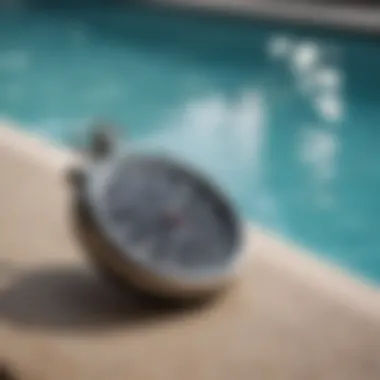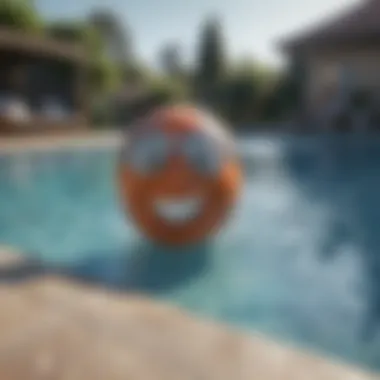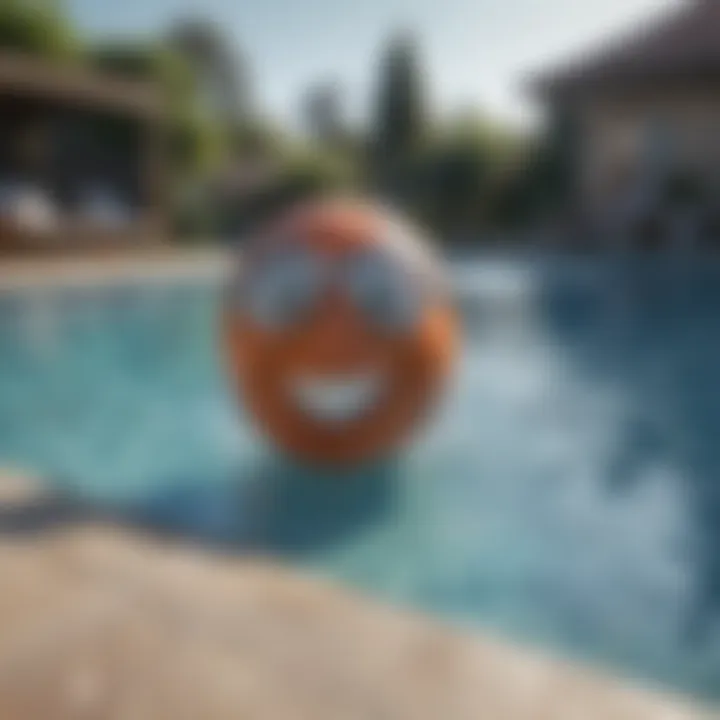Can You Swim After Shocking the Pool?


Intro
Keeping a pool clean and safe for use is essential for homeowners. One important aspect of this maintenance is shocking the pool, a process that involves adding a significant dose of chlorine or another sanitizer to eliminate contaminants. However, the question often arises: can you swim right after shocking the pool? Understanding this topic requires an exploration of the chemical processes involved, recommended waiting periods, and potential risks associated with swimming too soon.
Important Considerations
Pool shocking serves several purposes, mainly to destroy harmful bacteria and algae while ensuring that the water remains clear and inviting. The complexity of the chemicals involved means that it is vital to follow the correct procedures during and after shocking.
Safety first
Safety considerations should always be at the forefront of any pool maintenance task. After shocking, the chlorine levels in the pool rise significantly, making it potentially unsafe for swimmers. It is crucial to measure the chlorine concentration before deciding to swim. Optimal levels for safe swimming are generally below 5 parts per million (ppm).
Timing and Waiting Periods
After shocking the pool, the recommended waiting period to resume swimming is typically around 24 hours. This timeframe can vary depending on several factors, such as the type and amount of shock used, the pool's size, and the water temperature. Here are some key points to consider:
- Type of Shock: Different pool shock products can affect chlorine levels differently. For example, calcium hypochlorite will dissipate faster than sodium dichlor.
- Environmental Factors: Hot or windy weather may speed up the breakdown of chlorine.
- Pool Size: Larger pools dilute chemicals better, potentially allowing quicker swimming resumption.
Implications of Swimming Too Soon
Swimming soon after shocking can lead to skin irritations, eye irritation, and in extreme cases, respiratory issues due to high chlorine concentrations. Not only does this pose a risk to health, but it could also result in negative experiences that discourage future swimming.
Responsible Pool Use
To ensure the safety and enjoyment of swimming in your pool, managing chlorine levels and understanding the shocking process is crucial. Always wait for appropriate chlorine levels to return before entering the water. This not only safeguards the health of the swimmers but also ensures a pleasant swimming experience.
Closure
In summary, swimming directly after shocking a pool is not recommended. Homeowners should adhere to guidelines regarding waiting periods and chlorine levels to promote safety in the water. By understanding the chemical processes involved and the risks associated, one can maintain a safe and enjoyable swimming environment.
Understanding Pool Shocking
Pool shocking is a critical process for maintaining healthy water in your swimming pool. It involves adding a high dose of chemicals to water, typically chlorine or a non-chlorine shock, to eliminate contaminants. Understanding this process is vital for homeowners and pool enthusiasts alike. It not only aids in creating a safe swimming environment but also contributes to the overall longevity of the pool itself.
The importance of this topic extends beyond mere aesthetics; it is deeply intertwined with safety. Regular shocking prevents the growth of harmful bacteria and algae, thus ensuring a cleaner and safer swimming experience. Furthermore, this practice helps to prevent costly repairs by maintaining water balance, which can save money in the long term.
In this section, we will explore the specific elements of pool shocking, its benefits, and factors to consider, including timing and chemical application. Having a solid foundation in this subject can empower pool owners to make informed decisions, promoting not only enjoyment but also safety.
What is Pool Shocking?


Pool shocking refers to the process of adding a concentrated dose of chemicals to pool water to quickly raise the level of active sanitizers. The main purpose of shocking is to oxidize and break down organic matter like sweat, lotion, and dirt, as well as to kill bacteria and algae that can thrive in chlorinated water. It is often necessary after high usage, like parties, or heavy rain.
Typically, chlorine is used for this process, but there are alternative products like potassium peroxymonosulfate that some pool owners prefer. This method resets the water's chemical levels, ensuring cleanliness and clarity. Most experts recommend shocking the pool once every week or every other week during peak usage times.
Why is Pool Shocking Necessary?
Shocking the pool is essential for several reasons. First, it effectively removes contaminants that standard filtration may not eliminate. These include substances that accumulate over time or during heavy swimming sessions. If not addressed, these contaminants can lead to murky water or even form harmful bacteria and algae blooms.
Second, shocking helps maintain the correct balance of free chlorine, which is crucial for effective sanitation. Proper chlorine levels kill harmful pathogens in the water but tend to deplete quickly due to sunlight, heat, and swimmer load. Regular shocking ensures the chlorine is at an optimal level, maintaining a safe swimming environment.
Lastly, pool shocking aids in catching potential problems early on. If the water chemistry is routinely managed to include shock treatments, the risk of larger issues, such as algae blooms or cloudy water, is greatly minimized.
Common Chemicals Used in Pool Shocking
Several types of chemicals are commonly used in the pool shocking process. Understanding these options can help pool owners choose the right chemical for their specific needs. Some of the most frequently used shocking agents include:
- Calcium Hypochlorite: This is a common form of chlorine shock. It is a powerful oxidizer and helps raise free chlorine levels quickly.
- Sodium Dichloroisocyanurate: Often used as a stabilized form of chlorine, this is useful for pools exposed to sunlight, as it resists rapid breakdown.
- Potassium Peroxymonosulfate: This non-chlorine shock is ideal for pools that may have chlorine sensitivity. It works effectively at oxidizing contaminants without raising chlorine levels.
It is crucial to follow the manufacturer's instructions when using pool shocking chemicals, as improper handling can lead to safety risks and ineffective results.
Knowing the advantages of these different chemicals and their applications can aid homeowners in safeguarding their pools effectively.
The Physics of Pool Chemistry
Understanding the chemistry involved in pool shocking is crucial for safe swimming practices. When pool owners shock their pools, they initiate various chemical reactions that fundamentally alter the water's composition. This section investigates these chemical interactions and their implications on pH and chlorine levels. Recognizing the principles governing pool chemistry can help you make informed decisions about when it is safe to swim after shocking.
Chemical Reactions During Pool Shocking
When a pool is shocked, a high concentration of oxidizing agents is added to the water. These chemicals, such as chlorine or non-chlorine alternatives, work to eliminate chloramines and other contaminants. The process typically involves a rapid release of oxygen leading to oxidation of organic materials within the pool. The primary oxidizing agent for many pool shock treatments is sodium hypochlorite, which breaks down into free chlorine. This free chlorine then reacts with bacteria and other organic substances in the water.
Key chemical reactions during pool shocking include:
- Oxidation of Contaminants: This is the removal process where organic materials such as sweat, oils, and contaminants are transformed into less harmful substances.
- Chlorine Stabilization: After shocking, chlorine levels fluctuate. Understanding these changes helps determine safe swimming times.
These reactions are vital in maintaining pool hygiene but can lead to temporary imbalances in chemical composition. Knowing how these reactions occur helps users anticipate pH and chlorine variations that must be addressed before swimming.
Impact on pH and Chlorine Levels
Shocking a pool invariably affects its pH and chlorine levels. In general, chlorinated shocks tend to increase pH levels temporarily. A higher pH level can result in skin and eye irritation, making it important to wait until it returns to balanced levels before entering the water.
Here are critical factors influencing pH and chlorine levels post-shocking:
- Immediate Changes: Typically, chlorine levels spike significantly immediately after shocking, usually exceeding ideal ranges.
- pH Fluctuation: A sudden increase in pH can lead to unclear water and potential irritants for swimmers.
- Stabilizing Timeline: Following shocking, both pH and chlorine levels gradually stabilize. Full stabilization might take several hours or even a day, depending on various factors such as sun exposure and pool volume.


Health Risks Associated with Swimming Post-Shocking
Understanding the health risks associated with swimming after pool shocking is crucial for maintaining a safe swimming environment. When a pool is shocked, it usually involves the introduction of strong chemicals to eliminate contaminants. While the goal is to create clean water, these chemicals can pose risks if a swimmer enters the pool too soon after treatment. Therefore, it is vital to be aware of the potential side effects that might occur from exposure to residual chemicals.
Exposure to high levels of chlorine, along with other shocking agents, can lead to health problems that might range from mild irritation to more serious conditions. By understanding these risks, pool owners can make informed decisions about when it is safe to resume swimming after a pool shock treatment.
Skin and Eye Irritation
Swimming shortly after shocking can result in skin and eye irritation. Chlorine and other shocking compounds can cause symptoms such as rashes, redness, and dryness of the skin. For individuals with sensitive skin or existing conditions like eczema, this irritation can be particularly pronounced. Furthermore, water chemistry imbalances can lead to stinging and redness in the eyes, making swimming an unpleasant experience.
To mitigate these effects, waiting at least 24 hours after shocking before swimming is generally recommended. During this period, it is best to monitor the chemical levels closely to ensure they are back to safe ranges. Keeping the pool covered may also help prevent unnecessary exposure during this time.
Respiratory Issues
Swimming too soon after shocking can also lead to respiratory problems. The presence of high chlorine levels can create fumes that, when inhaled, may irritate the respiratory system. This is especially critical for individuals with asthma or other respiratory conditions.
Symptoms can range from mild cough to more severe issues like wheezing or difficulty breathing. In environments with poor ventilation, these issues can be exacerbated. Therefore, it is wise to ensure chlorine levels revert to normal before allowing anyone to swim. If there is ever uncertainty about the air quality above the pool water, it is best to err on the side of caution and postpone swimming.
"Waiting for appropriate chlorine levels post shocking ensures safety for all pool users and prevents discomfort or health complications."
In summary, both skin irritation and respiratory issues can arise from swimming in a freshly shocked pool. Taking time to understand these risks equips pool owners with critical knowledge to foster a safe swimming atmosphere.
Recommended Waiting Periods
Understanding the waiting periods after shocking your pool is critical for ensuring a safe swimming environment. When you shock a pool, you introduce high levels of chemicals, primarily chlorine, to eliminate contaminants. These chemicals can be harmful to humans, hence adhering to recommended waiting times is not just a precaution; it is necessary for health and safety.
Waiting periods help to ensure that the chemicals have time to dissipate to safe levels before swimming resumes. Factors such as the pool size, types of chemicals used, and prevailing environmental conditions can all influence these waiting times.
General Recommendations
General guidelines recommend to wait at least 24 hours after shocking the pool before swimming. This allows the chemicals time to break down and return to safe levels. More sensitive skin or respiratory issues might warrant a wait of up to 48 hours. Always check the current chemical levels using a test kit prior to jumping in.
Factors Influencing Waiting Times
Pool Size
Pool size plays a significant role in how long you need to wait after shocking. Larger pools dilute the chemicals more effectively than smaller ones. For instance, a community pool with a capacity of 30,000 gallons may require a shorter waiting period than a small residential pool containing 10,000 gallons. This characteristic can make larger pools a better option for those who want to maintain optimal conditions with less chemical overload. However, ensure regular monitoring to confirm that chemical levels are safe.
Chemical Type
Different types of shocking agents have varying effects on water chemistry. For example, calcium hypochlorite adds both chlorine and calcium to the water, while sodium dichlor is more stable and dissolves faster. The unique features of the chemical type used can significantly influence how long you should wait after shocking. Potassium monopersulfate is another popular choice and doesn’t raise chlorine levels as much, leading to shorter waiting periods. Evaluate the chemical type being used to determine a suitable waiting timeframe.
Environmental Conditions


Environmental factors, such as temperature, sunlight, and weather conditions, also affect the breakdown of pool chemicals. For example, sunny days aid in quicker dissipation of chlorine due to UV exposure. Conversely, in cooler or cloudy conditions, chemicals might linger longer in the water. Understanding these conditions is crucial for deciding the appropriate waiting period. Keeping an eye on outdoor factors ensures you are always swimming in a safe environment.
The understanding of waiting periods after shocking a pool is essential not just for safety but also for overall enjoyment.
Monitoring Pool Chemistry After Shocking
Monitoring pool chemistry after shocking is a crucial aspect of maintaining a safe and enjoyable swimming environment. When pool shocking occurs, significant changes in chemical composition and balance take place. Therefore, it is vital to regularly check these levels to ensure that they return to safe parameters before swimming.
Testing pH and Chlorine Levels
One of the first steps in monitoring pool chemistry includes testing the pH and chlorine levels. Both of these parameters are essential for pool safety and clarity.
- pH Levels: The pH scale measures the acidity or alkalinity of the water. Ideally, pH should maintain a range between 7.2 to 7.8. Any deviations can lead to skin irritations or corrosion of pool equipment.
- Chlorine Levels: Chlorine is often used in pool shocking to sanitize the water. After shocking, the recommended chlorine level should usually fall between 1 to 3 parts per million (ppm). Levels above this can result in unpleasant swimming conditions.
Regular testing is vital. Use a test strip, liquid test kit, or automated sensor. Take these readings a few hours after shocking and continue checking every day or as per the needs of your pool environment.
Using Pool Test Kits
Utilizing pool test kits is an effective way to monitor your pool chemistry accurately. These kits come in various forms, including strips or drop tests, and are essential tools for every pool owner.
- Types of Kits: You can choose from colorimetric kits, which provide visual results using color changes, or digital testers that offer quick readings with more precision.
- Usage: Follow the instructions provided with your kit. Generally, you will need to collect a sample of pool water and either dip the test strip or add reagents for color changes.
In addition to pH and chlorine levels, other parameters such as alkalinity and stabilizer levels should also be part of regular testing. Addressing these can help maintain overall pool health, ensuring a pleasant swimming experience.
Regular testing and monitoring provides a peace of mind, knowing your pool is safe for use.
In summary, actively monitoring your pool chemistry after shocking is essential for preventing health risks and enhancing the longevity of your pool equipment. Investing time in proper testing and utilizing reliable pool test kits will lead to a more enjoyable and safer swimming environment.
Culmination and Best Practices
In this article, we have explored the intricacies of swimming after shocking a pool. Understanding the implications of pool shocking not only ensures health and safety but also enhances the overall pool experience. Best practices, when adhered to, contribute to the longevity of the pool's water quality and the well-being of its users.
One vital element is the importance of observing the recommended waiting times after shocking. This process involves letting the chemicals stabilize before allowing anyone to swim. Ignoring this can lead to skin irritations, respiratory issues, or more severe health concerns. Therefore, knowledge about this aspect cannot be overstated.
Furthermore, it's crucial to implement a routine of regular maintenance. This routine ensures that the pool's chemical balance is consistently monitored and maintained, creating a safer swimming environment. Lastly, educating pool users about the effects of pool shocking as well as safe swimming practices reinforces personal responsibility and collective safety among users.
Final Thoughts on Swimming After Shocking
Swimming after shocking a pool is a decision that should not be taken lightly. The timing must be considered seriously to avoid health risks. Chemical levels fluctuate during and after shocking, so understanding when it is safe to jump back in is key. Serous effects can happen from not waiting long enough. Users should have patience and follow the guidance provided in this article.
Creating a Safe Swimming Environment
Regular Maintenance Routine
A regular maintenance routine is fundamental for healthy pool water. Keeping track of the chemical balance, including pH levels and chlorine concentration, ensures a safe experience for swimmers. Regular checks reduce the risks of health problems and pool inefficiency. It is also a proactive approach to preventing larger issues like algae growth or unsafe water conditions. Choosing this routine is a beneficial option for pool owners, as it saves time and money in the long run.
Educating Pool Users
Educating pool users is vital in managing safety standards. Informing users about the effects of pool chemicals and safe swimming practices raises awareness and encourages responsible behavior. This aspect can alleviate concern during pool parties or gatherings. By providing proper information, users become more conscious of when to wait after shocking and what signs of irritation to watch for. This approach fosters a culture of safety among users, making it an essential practice for any pool owner.







